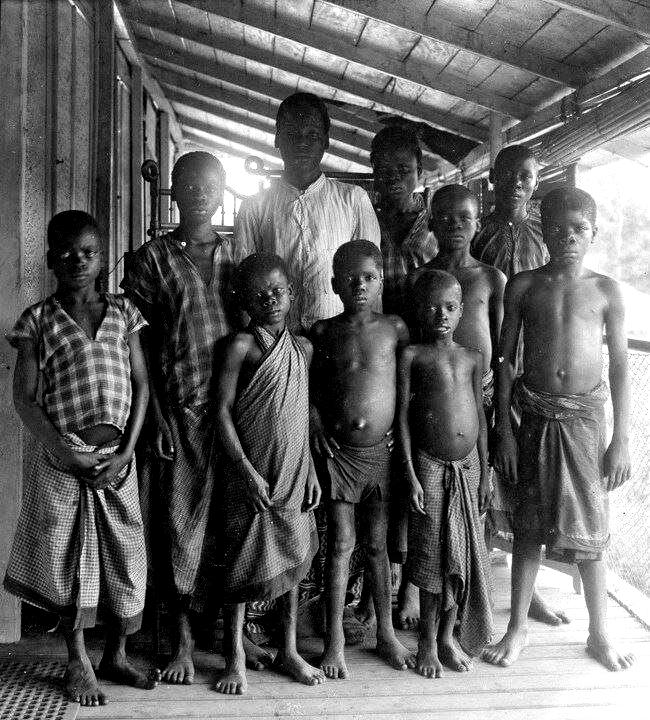
Gabon: Religious Faiths--Christianity

Figure 1.-- This photograph was taken in the early-20th century on the porch of an Evangelical Mission in Gabon, giving us insights into the missionaries' ideas of modesty on local clothing conventions. As you can see the boys were asked to cover thei pelvis area in some way. The girls also were expected to cover their chest. As everyone has short hair itis difficult to discern gender, but the children with shirts are probably the girls, xcept of course the older teen wearing a white shirt. This difference, obvious in the European culture, was unknown to the local people. Traditionally the children went unclothed, and the adults only covered the pelvis, both men and women. Gabon on the equator has one of the world's warmest climates.
|
|
Gabon is a largely Christian country. Something like 75 percent of the population identifies as being Christian. Some estimates are as low as 60 percent. A majority of Gabonese Christians are Catholic as a result of French colonial rule. Gabon is a relatively small country. And unlike many countries most of the country is located close to the coast. Thus the colnial experuence was more intense than the case of much of africa. Christian missionaries have been active in Gabon since the early-19th century. The Church in Gabon still relies on foreign clergy, especially the French Holy Ghost Fathers. There are also, however, Gabonese ckergy as well. Catholic churches are located throughout the country. The Protestant denominations have more regional bases. In recent years there has been a growing evagelical movement with Christian Alliance Church in the southwest. There also is a tiny Evangelical Pentecostal Church (Assembly of God) in the estuary and far northern regions. A French reader thinks that the image here
gives an incorrect impression about Christianity in Gabon. He writes, "This HBC image, about Gabon are not epresentative of the French colonial life overthere. In 1910 , Protestant evangelical mission in Gabon and Congo were practicly nothing. Their means of existance missions were quite very precarious. Several pastors came with their children and got very few financial aid. They lived in povrety. I think their children were not happy. The French catholic mission were encouraged and they were perfectly structured. Plenty schools were created, the French was teached. Libreville town
and harbour were modernised. About 1920, Gabon was christianised catholic 85%, and may be only 3-4 percent evangelic.
Every colonial settler, before leaving France recieved a notebook with some instructions. They was noted into, all necessery recommendations to live in Africa. By instance : Avery one must keept his pith white colonial helmat to go out against the sun. Barefoot was dangerous in raison the floor. They must to wear suitable garments adapted to the climat. Lover affair with local people were dangerous in raison seriously diseases. By this way, you will never able to see one 1910 image about French or Belgian child without his pith helmet and getting out barefoot. After 1935 the pith helmet was considered anymore necessery in town. To day, more tgan 80 percent of Gabon people speek a good French."
HBC

Navigate the Boys' Historical Clothing Web Site:
[Introduction]
[Activities]
[Biographies]
[Chronology]
[Cloth and textiles]
[Clothing styles]
[Countries]
[Topics]
[Bibliographies]
[Contributions]
[FAQs]
[Glossaries]
[Images]
[Links]
[Registration]
[Tools]
[Boys' Clothing Home]
Navigate the Boys' Historical Clothing national pages:
[Return to the Min Gabonese religion page]
[Return to the Main Gabon page]
[Return to the Main Gabon history page]
[Return to the Main African page]
[Angola]
[Cape Verde Islands]
[Democratic Republic of the Congo]
[Lessotho]
[Madagascar]
[Mali]
]South Africa]
[Uganda]
[France]
Created: 5:11 PM 3/28/2016
Last updated: 5:11 PM 3/28/2016



